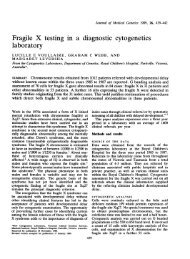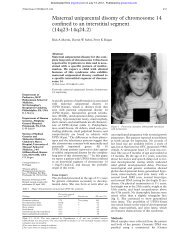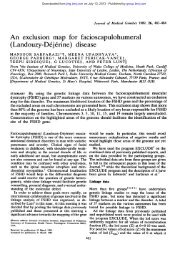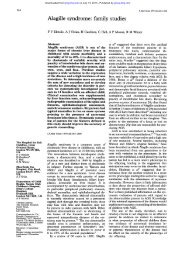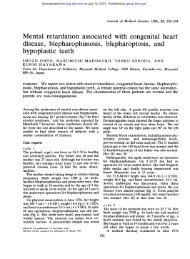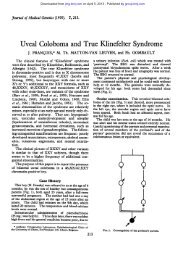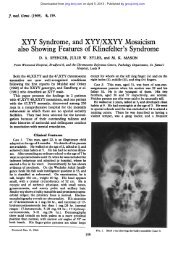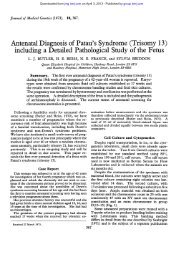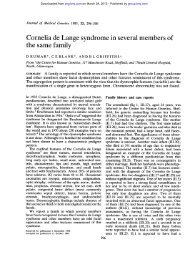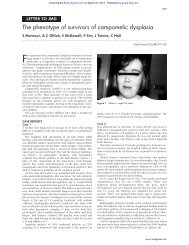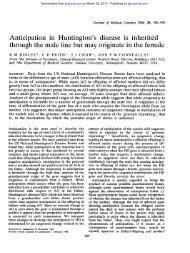Pre-eclampsia/eclampsia in twin pregnancies - Journal of Medical ...
Pre-eclampsia/eclampsia in twin pregnancies - Journal of Medical ...
Pre-eclampsia/eclampsia in twin pregnancies - Journal of Medical ...
Create successful ePaper yourself
Turn your PDF publications into a flip-book with our unique Google optimized e-Paper software.
Downloaded from<br />
jmg.bmj.com on July 13, 2013 - Published by group.bmj.com<br />
cause <strong>of</strong> the greatly <strong>in</strong>creased <strong>in</strong>cidence <strong>of</strong> pre<strong>eclampsia</strong><br />
<strong>in</strong> tw<strong>in</strong>s, they must be the result <strong>of</strong> the DZ<br />
tw<strong>in</strong>s which comprise about two-thirds <strong>of</strong> the total<br />
<strong>in</strong> Caucasian populations (Stevenson et al, 1971).<br />
Even if our data are ignored, it would be surpris<strong>in</strong>g<br />
if a threefold total <strong>in</strong>crease could be the result <strong>of</strong><br />
<strong>in</strong>creased antigenic differences between mother and<br />
fetuses <strong>in</strong> two-thirds <strong>of</strong> the tw<strong>in</strong>s. If <strong>in</strong> a s<strong>in</strong>gleton<br />
pregnancy the conceptus antigens not expressed <strong>in</strong><br />
the mother are F, it follows that the number <strong>of</strong><br />
antigens <strong>in</strong> a DZ pregnancy not expressed <strong>in</strong> the<br />
mother would be < 2F, and this maximum <strong>in</strong>crease<br />
could only produce a rise <strong>in</strong> the pre-<strong>eclampsia</strong>/<br />
<strong>eclampsia</strong> <strong>in</strong>cidence <strong>of</strong> < 2/3 x 2 = < 1.3 while the<br />
observed factor is 3.<br />
Conclusion<br />
While this study fails to show any consistent difference<br />
<strong>in</strong> the <strong>in</strong>cidence <strong>of</strong> pre-<strong>eclampsia</strong>/<strong>eclampsia</strong><br />
between DZ and MZ tw<strong>in</strong> <strong>pregnancies</strong>, it does confirm<br />
the very greatly <strong>in</strong>creased <strong>in</strong>cidence <strong>of</strong> pre<strong>eclampsia</strong><br />
<strong>in</strong> association with tw<strong>in</strong>s-a threefold<br />
order compared with s<strong>in</strong>gletons. On a quantitative<br />
basis, consider<strong>in</strong>g numbers <strong>of</strong> antigen differences as<br />
a possible factor <strong>in</strong> caus<strong>in</strong>g pre-<strong>eclampsia</strong>, one<br />
would expect tw<strong>in</strong> <strong>pregnancies</strong> to show an <strong>in</strong>crease<br />
<strong>of</strong> < 1-3. If total antigen 'dose' were <strong>in</strong>volved<br />
it would be < 2. The observed <strong>in</strong>crease is<br />
greater than this particularly <strong>in</strong> the severe form <strong>of</strong><br />
the disease. Furthermore, as <strong>in</strong>dicated, the figures<br />
probably give an underestimate <strong>of</strong> the difference.<br />
Apparently the factor(s) responsible for the <strong>in</strong>-<br />
<strong>Pre</strong>-<strong>eclampsia</strong>/<strong>eclampsia</strong> <strong>in</strong> tw<strong>in</strong> <strong>pregnancies</strong><br />
211<br />
creased <strong>in</strong>cidence <strong>of</strong> pre-<strong>eclampsia</strong> <strong>in</strong> tw<strong>in</strong>s do not<br />
represent a mere summation <strong>of</strong> those operative <strong>in</strong><br />
two s<strong>in</strong>gleton <strong>pregnancies</strong>.<br />
REFERENCES<br />
Adams, E. M. and MacGillivray, I. (1961). Long term effect <strong>of</strong><br />
pre-<strong>eclampsia</strong> <strong>in</strong> blood pressure. Lancet, 2, 1373-1375.<br />
Benirschke, K. and Driscoll, S. G. (1967). The placenta <strong>of</strong> multiple<br />
pregnancy. In The Pathology <strong>of</strong> the Human Placenta, p. 165.<br />
Spr<strong>in</strong>ger-Verlag, Berl<strong>in</strong>, Heidelberg New York.<br />
Cameron, A. H. (1968). The Birm<strong>in</strong>gham tw<strong>in</strong> survey. Proceed<strong>in</strong>gs<br />
<strong>of</strong> the Royal Society <strong>of</strong> Medic<strong>in</strong>e, 61, 229-234.<br />
Enders, T. and Stern, C. (1948). The frequencies <strong>of</strong> tw<strong>in</strong>s, relative<br />
to age <strong>of</strong> mothers, <strong>in</strong> American populations. Genetics, 33, 263.<br />
James, W. H. (1971). Excess <strong>of</strong> like-sexed pairs <strong>of</strong> dizygotic tw<strong>in</strong>s.<br />
Nature (London), 232, 277-278.<br />
Kalmus, H. (1946). Genetical antigenic <strong>in</strong>compatibility as a possible<br />
cause <strong>of</strong> the toxaemias occurr<strong>in</strong>g late <strong>in</strong> pregnancy. Annals<br />
<strong>of</strong> Eugenics, 13, 146-149.<br />
McCartney, C. P. (1964). Pathological anatomy <strong>of</strong> acute hypertension<br />
<strong>of</strong> pregnancy. Circulation, 29 and 30, Suppl. 11, 37-42.<br />
Naeye, R. L. (1964). Fetal and neonatal development <strong>of</strong> tw<strong>in</strong>s.<br />
Pediatrics, 33, 546-553.<br />
Nylander, P. P. S. (1970). The determ<strong>in</strong>ation <strong>of</strong> zygosity-a study<br />
<strong>of</strong> 608 pairs born <strong>in</strong> Aberdeen. <strong>Journal</strong> <strong>of</strong> Obstetrics and Gynaecology<br />
<strong>of</strong> the British Commonwealth, 77, 506-510.<br />
Papiernik, E., Gerard, L., Hult, A. M., and Schneider, L. (1974).<br />
Hypothesis <strong>of</strong> an ovular regulation <strong>of</strong> pregnancy weight-ga<strong>in</strong>.<br />
Acta Geneticae Medicae et Gemellologiae, 23, 56.<br />
Penrose, L. S. (1946). On the familial appearances <strong>of</strong> maternal and<br />
fetal <strong>in</strong>compatibility. Annals <strong>of</strong> Eugenics, 13, 141-145.<br />
Platt, R., Stewart, A. E., and Emery, E. W. (1958). The aetiology,<br />
<strong>in</strong>cidence and heredity <strong>of</strong> pre-eclamptic toxaemia <strong>of</strong> pregnancy.<br />
Lancet, 1, 552-556.<br />
Salzmann, K. D. (1955). Do transplacental hormones cause<br />
<strong>eclampsia</strong> ? Lancet, 2, 953-956.<br />
Selv<strong>in</strong>, S. (1971). The number <strong>of</strong> <strong>pregnancies</strong> prior to the birth <strong>of</strong><br />
tw<strong>in</strong>s. Annals <strong>of</strong> Human Genetics, 34, 427-429.<br />
Stevenson, A. C., Davison, B. C. C., Say, B., Ustuoplu, S., Lya, D.,<br />
and Toppozoda, H. K. (1971). Contribution <strong>of</strong> fetal,/maternal<br />
<strong>in</strong>compatibility to aetiology <strong>of</strong> pre-eclamptic toxaemia. Lancet,<br />
2, 1286-1289.<br />
Toivanen, P. and Hirvonen, T. (1970). Sex ratio <strong>of</strong> newborns: preponderance<br />
<strong>of</strong> males <strong>in</strong> toxaemia <strong>of</strong> pregnancy. Science, 170, 187-<br />
188.





